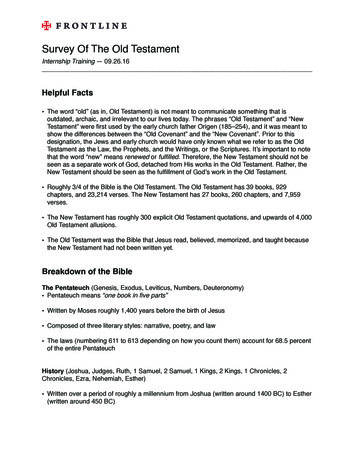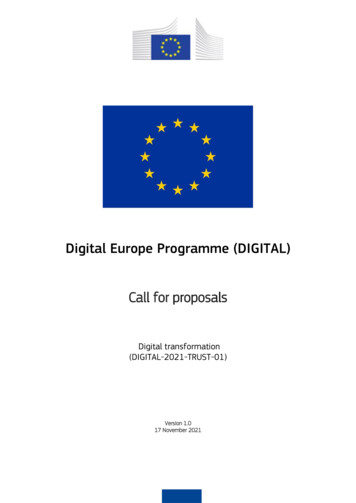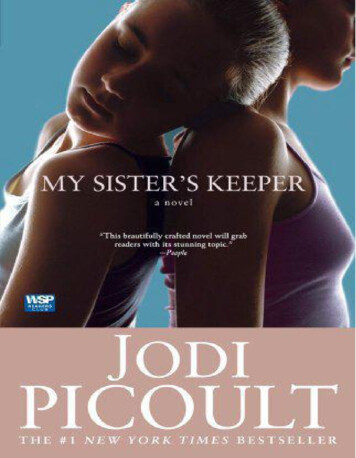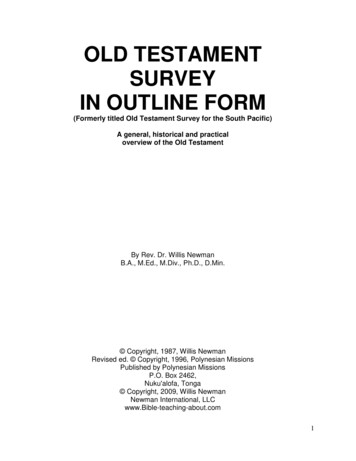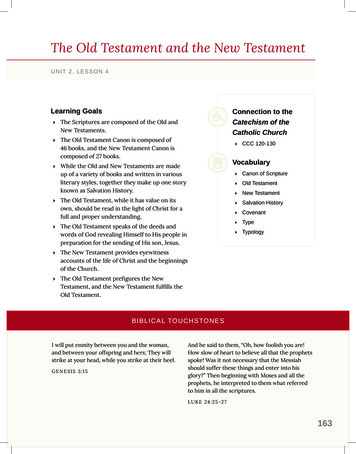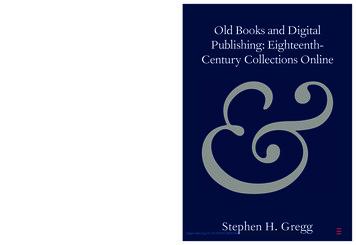
Transcription
Old Books and Digital Publishing: Eighteenth-Century Collections OnlineCambridge Elements in Publishing and Book CultureSeries Editor:Samantha RaynerUniversity College LondonAssociate Editor:Leah TetherUniversity of BristolGREGGThis is a history of Eighteenth Century Collections Online(ECCO), a database of more than 180,000 titles. Published byGale in 2003, it has had an enormous impact on the study ofthe eighteenth century. Like many commercial digital archives,ECCO’s continuing development obscures its precedents. ThisElement examines its prehistory as first a computer catalogue ofeighteenth-century print, and then as a commercial microfilmcollection, before moving to the digitisation and development ofthe interfaces to ECCO, as well as Gale’s various partnershipsand licensing deals. An essential aspect of this Element is howit explores the sociocultural and technological debates aroundaccess to old books from the 1930s to the present: StephenGregg demonstrates how these contexts powerfully shape theway ECCO works to this day. This Element’s aim is to make usbetter users and readers of digital archives.Old Books and DigitalPublishing: EighteenthCentury Collections OnlinePublishing and Book CultureAcademic PublishingISSN 2514-8524 (online)ISSN 2514-8516 (print)Stephen H. Gregghttps://doi.org/10.1017/9781108767415 Published online by Cambridge University Press
https://doi.org/10.1017/9781108767415 Published online by Cambridge University Press
Elements in Publishing and Book Cultureedited bySamantha RaynerUniversity College LondonOLD BOOKS AND DIGITALPUBLISHING:EIGHTEENTH-CENTURYCOLLECTIONS ONLINEStephen H. GreggBath Spa Universityhttps://doi.org/10.1017/9781108767415 Published online by Cambridge University Press
University Printing House, Cambridge CB2 8BS, United KingdomOne Liberty Plaza, 20th Floor, New York, NY 10006, USA477 Williamstown Road, Port Melbourne, VIC 3207, Australia314–321, 3rd Floor, Plot 3, Splendor Forum, Jasola District Centre,New Delhi – 110025, India79 Anson Road, #06–04/06, Singapore 079906Cambridge University Press is part of the University of Cambridge.It furthers the University’s mission by disseminating knowledge in the pursuit ofeducation, learning, and research at the highest international levels of excellence.www.cambridge.orgInformation on this title: www.cambridge.org/9781108720694DOI: 10.1017/9781108767415 Stephen H. Gregg 2020This publication is in copyright. Subject to statutory exceptionand to the provisions of relevant collective licensing agreements,no reproduction of any part may take place without the writtenpermission of Cambridge University Press.First published 2020A catalogue record for this publication is available from the British Library.ISBN 978-1-108-72069-4 PaperbackISSN 2514-8524 (online)ISSN 2514-8516 (print)Cambridge University Press has no responsibility for the persistence or accuracy ofURLs for external or third-party internet websites referred to in this publicationand does not guarantee that any content on such websites is, or will remain,accurate or appropriate.https://doi.org/10.1017/9781108767415 Published online by Cambridge University Press
Old Books and Digital Publishing:Eighteenth-Century CollectionsOnlineElements in Publishing and Book CultureDOI: 10.1017/9781108767415First published online: November 2020Stephen H. GreggBath Spa UniversityAuthor for correspondence: Stephen H. Gregg, s.gregg@bathspa.ac.ukAbstract: This is a history of Eighteenth Century CollectionsOnline (ECCO), a database of more than 180,000 titles.Published by Gale in 2003, it has had an enormous impact onthe study of the eighteenth century. Like many commercialdigital archives, ECCO’s continuing development obscures itsprecedents. This Element examines its prehistory as firsta computer catalogue of eighteenth-century print, and then asa commercial microfilm collection, before moving to thedigitisation and development of the interfaces to ECCO, aswell as Gale’s various partnerships and licensing deals. Anessential aspect of this Element is how it explores thesociocultural and technological debates around access to oldbooks from the 1930s to the present: Stephen Greggdemonstrates how these contexts powerfully shape the wayECCO works to this day. This Element’s aim is to make usbetter users and readers of digital archives.KEYWORDS: books, remediation, history, digital publishing, eighteenthcentury Stephen H. Gregg 2020ISBNs: 9781108720694 (PB), 9781108767415 (OC)ISSNs: 2514-8524 (online), 2514-8516 (print)https://doi.org/10.1017/9781108767415 Published online by Cambridge University Press
ttps://doi.org/10.1017/9781108767415 Published online by Cambridge University Press103
posal for an eighteenth-century short title catalogue.Cataloguing on the Eighteenth-Century Short TitleCatalogue (18thC STC) begins in earnest from around 1978.British Library signs contract with Research Publications(RPI) to microfilm its eighteenth-century books based on the18thC STC. Microfilming and production on the collection,called The Eighteenth Century, begins in 1982.18thC STC cataloguing expanded to include pre-1700material.Microfilming operation expanded.The 18thC STC renamed the English Short Title Catalogue(ESTC).RPI becomes Primary Source Media (PSM).Thomson Learning decides to begin digitising its collections.PSM, Information Access Company, and Gale Research mergeto form Gale Group, part of Thomson Learning.ProQuest launches Early English Books Online (EEBO).Text Creation Partnership (TCP) formed.ECCO digitisation begins.Gale Group becomes Thomson-Gale.Eighteenth Century Collections Online published.TCP schedule for transcribing and publishing ECCO-TCPtexts.UK organisation Jisc purchases ECCO files under license.Thomson Group sells Thomson Learning to private equityfirms and it is renamed Cengage Learning. Gale becomes animprint of Cengage.Cross-search with EEBO added to interface.https://doi.org/10.1017/9781108767415 Published online by Cambridge University Press
2020TimelineECCO II publishes more than 46,000 extra titles from scansdone between 2003 and 2009. Subject field added. Opticalcharacter recognition (OCR) software replaced. ESTC andECCO metadata enhanced by adding Library of Congresssubject headings.End of microfilming programme.BiblioLife produces print-on-demand copies of ECCO titles.18thConnect website launched.Jisc Historic Books platform launched.TCP releases c.2,200 ECCO-TCP texts.Jisc Historic Books redesigned and relaunched as HistoricalTexts.Gale launches ‘Textual Data Analysis’ hard drives.Gale offers an additional ECCO interface option calledArtemis.Artemis renamed Gale Primary Sources.Gale Digital Scholar Lab (beta) platform launched.Gale begins digitising a further c.90,000 books for futurepublication as ECCO III.Original ‘stand-alone’ ECCO interface scheduled to be turnedoff.https://doi.org/10.1017/9781108767415 Published online by Cambridge University Press
Old Books and Digital Publishing11 IntroductionEighteenth Century Collections Online (ECCO) is an online databasepublished by Gale-Cengage. First published in 2003, it gives access viasubscribing libraries to 184,536 titles of material printed between 1700 and1800, comprising the text and digital images of their pages. In 2020 2,092institutions and consortia in forty-two countries subscribe; in 2019 around7.7 million search results, images, or texts were retrieved worldwide (DeMowbray, 2020a). It is arguably the largest single online collection ofspecifically eighteenth-century material available via academic institutionsand has had a profound impact on how researchers conduct scholarship ofthe period. A history of a digital resource like ECCO is important because ifwe are at all interested in old books, and assuming we’re also aware of theexponential increase in accessing old books via resources like ECCO, thenwe should be interested in why digitised books look the way they do and thedifference that makes, how ECCO works the way it does, and what wecan – and can’t – do with these books.Eighteenth Century Collections Online is deeply rooted in a longerhistory of representing eighteenth-century books, the effect of which canstill be traced in the way ECCO works, since it is based upon a commercialmicrofilm collection, The Eighteenth Century, the contents of which wereselected on the basis of a computerised cataloguing programme, theEighteenth-Century Short Title Catalogue (18thC STC). As Sarah Wernerand Matthew Kirschenbaum argue, we cannot ‘posit a transcendental “digital” that somehow stands outside the historical and material legacies of otherartifacts and phenomena’; rather, the digital is a ‘frankly messy complex ofextensions and extrusions of prior media and technologies’ (Kirschenbaum &Werner, 2014: 408; my emphasis).This is why this book starts with a ‘prehistory’ in order to understand thetwentieth-century contexts of earlier media technologies, the changing cultures of scholarship, and what was driving commercial academic publishing.The first section draws out two significant factors from the 18thC STC(begun in 1976). The first is that decisions had to be made about whatmaterial it would include and what material it would not – these decisionswould subsequently affect the scope and nature of ECCO’s content.https://doi.org/10.1017/9781108767415 Published online by Cambridge University Press
2Publishing and Book CultureThe second is that the catalogue was from the outset a digital project, but thatpresented a challenge: how would the idiosyncratic features of books produced by the hand press translate into standardised machine-readable data?This metadata (data about something, rather than the thing itself) wouldeventually shape how ECCO could be searched as well as how usersapprehend the nature of old books when they are digital images.The second section moves to Research Publication’s (RPI) microfilm collection, The Eighteenth Century (published from 1982 onwards). It sets out thescholarly and commercial contexts for the development of this new mediatechnology from the 1930s to the end of the twentieth century, illuminatingthe arguments of scholars, libraries, and microfilm companies for how thisnew technology would enable the preservation of and enable a wider access toresearch materials and old books.At this point it’s worth establishing why a focus on the books withinECCO is important. My approach to the idea of the book is predicatedon a series of axioms:1. The form of the printed book is a particular medium for the wordswithin (as opposed to, say, a scroll or an audiobook).2. The meaning of a book does not solely consist of the words within; thematerial form and the design of the book itself have meaning.3. Transform the book into another medium (‘remediation’) and youchange the meanings of the book.It’s for these reasons that this book, in the chapter ‘Bookishness’, looks atsome case studies of individual eighteenth-century books in order toexemplify the effects of the 18thC STC and the microfilming programmeon how users apprehend the physicality – the material life – of hand-pressbooks as they are presented as digital images in ECCO. Part of this isa study of how users navigate between the image of a book and its record(spoiler: there is no seamless ‘fit’), but it also emphasises the effect ofhuman agency and human decisions about technology on how old bookslook in ECCO. In this sense my conceptual framework for this history isindebted to the powerful arguments for the critical potential of bookhistory D. F. McKenzie made in his lectures of 1985, in which he proposedthat bibliography should concern itself with a ‘sociology of texts’. I starthttps://doi.org/10.1017/9781108767415 Published online by Cambridge University Press
Old Books and Digital Publishing3with his point that the term ‘texts’ should go beyond the printed text toencompass the very broadest set of human communication media andeven – most vital for us – ‘computer-stored information’; there is, heargues, ‘no evading the challenge which those new forms have created’(McKenzie, 1999: 13). The discipline of bibliography ‘studies texts asrecorded forms, and the processes of their transmission, including theirproduction and reception’ (12). Perhaps the strongest argument for myhistory is that a ‘sociology of texts’ should allow ‘us to describe not onlythe technical but the social processes of their transmission’, and it ‘directsus to consider the human motives and interactions which texts involve atevery stage of their production, transmission, and consumption. It alertsus to the role of institutions, and their own complex structures, in affectingthe forms of social discourse, past and present’ (McKenzie, 1999: 13, 15).Sociocultural forces, institutions, technology, and human agency all playtheir part in this history.Eighteenth Century Collections Online – or any digital entity – is nota static or an unchanging entity: it has a history. The rapidity with whichcommercial publishing technology supersedes older versions of itself hasmeant that some circumstances of its development are now obscure andothers are irrecoverable. Tellingly, a part of ECCO will become invisible from 2020 when its original interface is scheduled to be turned off: itwill literally be history. So this book is partly an act of recovery. Thethird chapter, ‘Beginnings’, turns to the development of ECCO itself. Inthe first section, I examine the immediate contexts that shaped howECCO was to work and to be sold. It was decisively influenced by thedownward movement of the academic publishing market and the emerging so-called disruptive technologies in the 1990s (Bower &Christensen, 1995). I focus on the techno-commercial choices facingGale by illustrating contemporary digital resources created by two ofits key commercial competitors in academic publishing of the time:Chadwyck-Healey and ProQuest. In addition, some aspects of howECCO works ‘under the hood’ are – in common with many digitalproducts – simply invisible to the public. The chapter goes on to explainGale’s digitisation of the microfilm collection, discussing the problemscreated by the use of optical character recognition (OCR) software tohttps://doi.org/10.1017/9781108767415 Published online by Cambridge University Press
4Publishing and Book Cultureautomatically create text from digital images of old books, how itsmetadata was structured, and how ECCO’s original search interfaceworked.The chapter ‘Interfacing’ takes us forward to Gale’s development ofECCO after 2010, but also returns us to the issues of access. First, itfocuses on the conglomerate of deals and collaborations between Gale andvarious partners, all of which broadly attempted to address concerns aboutwho could access ECCO, as well as how ECCO might be used andinterrogated, including the Text Creation Partnership, Jisc, and the print-on-demand deal with BiblioLife. This chapter’s last section discusses theeffects and meanings of the rise of the platform: this enabled the crosssearching of aggregated digital resources in a single package, but alsoa new way of interfacing with data and texts that was – for Gale’splatforms – influenced by their belated engagement with the scholarlyfield of digital humanities. However, the platform produces a crucialtension between two ways of understanding and using old books: thebibliographical (or the ‘bookishness’ of books) and the textual. I finish byconsidering the politics of how these platforms represent early printhistory, drawing on the insights of postcolonial digital humanities, andreminding us that the Anglocentric nature of digital resources like ECCOis a product – a partially obscured one – of human decisions made in itsantecedents, the 18thC STC and the microfilm collection. Indeed,throughout the book I’ve tried to avoid the suggestion that technologicalchange is the only driving force in the twentieth and twenty-first centuries; instead I hope to have demonstrated that in ECCO’s history –indeed, in the history of remediating and publishing old books – technology is inextricable from culture and human decisions.I intend my history of a digital resource to mirror the methodology ofbibliography. As W. W. Greg argued:the object of bibliographical study is, I believe, to reconstruct for each particular book the history of its life, to makeit reveal in its most intimate detail the story of its birth andadventures as the material vehicle of the living word. (Greg,1945: 27)https://doi.org/10.1017/9781108767415 Published online by Cambridge University Press
Old Books and Digital Publishing5Like the life history of old books, I hope to reveal the intimate details of thelife history of ECCO: this book is partly an argument for the application ofbibliography to digital entities, conceived as a ‘material vehicle of the livingword’.1 Looking over my introduction I hope it’s also clear that the status ofentities like ECCO and their digitised books actually challenges the notionof a linear, progressive history. First, as Bonnie Mak has noted of books thathave been subject to remediation, past and present versions of the samebook copy exist simultaneously; in our case, as catalogue, as record, asmicrofilm, as digital images, as digital text, and even as a print-on-demandcopy (Mak, 2014: 1516, 1519). This is echoed in the movement between pastand present when we discuss ECCO’s place within wider historical contexts. Alan Liu’s comment about how we imagine and write narratives ofmedia is suggestive: ‘the best stories of new media encounter – emergentfrom messy, reversible entanglements with history, socio-politics, and subjectivity – do not go from beginning to end, and so are not really stories atall’ (Liu, 2013: 16, my emphasis).My aim is to speak to people interested in old books, people interested inhow digitised collections of books work, and people interested in the historyof how new media technologies have affected academic publishing. Withsuch a broad reader in mind, I have tried not to assume any expert knowledge of old books, technology, or academic publishing even though thismeans taking the odd digression to explain a microhistory of file formats, ormicrofilm publishing, or some bibliographical terminology. The challengeof my history is to trace the digressive reverberation of ideas and debatesthat surrounded how we access and what we do with old books, and thechronological messiness of books whose lives have been subject to constantchange. But this history is more than that; it is also an argument that weshould better grasp the nature of something students and scholars rely uponfor their understanding of eighteenth-century print and an argument forrecovering, reading, and researching digital resources critically.1This book’s methodology is indebted to the interface between book history anddigital humanities; in addition to those cited here see, for example, the work byRyan Cordell, Johanna Drucker, Alan Galey, Jerome McGann, and 415 Published online by Cambridge University Press
6Publishing and Book Culture2 PrehistoryCataloguing the Eighteenth CenturyEighteenth Century Collections Online is based on a microfilm collectionproduced between 1982 and the early 2000s. This film collection itself wasbased on a catalogue of books begun in 1976 called the Eighteenth-CenturyShort Title Catalogue, under the editorship of Robin Alston, consultant atthe British Library, co-edited with Henry Snyder in the United States. From1987 this project expanded to include material printed before 1700 and waseventually renamed the English Short Title Catalogue (ESTC). In itscurrent form the ESTC is an online catalogue of printed material publishedfrom the fifteenth century to the end of the eighteenth century. It’s difficultto capture the sheer scale of the ESTC and its ambition: looking back overthe project from 2003, Thomas Tanselle reaches for numbers: the ‘file(achieved at a cost of about 30 million dollars) consists of some 435,000records, indicating the location of over 2,000,000 copies in 1,600 librariesaround the world’ (in Snyder & Smith, 2003: xi). Currently it comprisesmore than 480,000 records from 2,000 libraries worldwide.2 However, theproject was initially confined to material printed between 1700 and 1800, andbecause it is this that shaped the underlying nature of ECCO, this historyconcentrates on the catalogue project before 1987.3The first discussions about the possibility of a catalogue that wouldcover the eighteenth century began as early as 1962 amongst members of theBibliographical Society, and such a catalogue was perceived as the logicalnext step from the two Short Title Catalogues (STCs) covering materialprinted between 1475 and 1640 (Pollard and Redgrave) and 1641 and 1700(Wing). However, it was from 1975 that the catalogue got the necessarybacking to start. More significantly, the discussions and plans by the leadingeditors for the 18thC STC emphasised the necessity that it be produced as23British Library – Projects – English Short Title Catalogue: www.bl.uk/projects/english-short-title-catalogue? ga 3819 [accessed 27 May 2020].I refer to the project between 1976 and 1987 as the 18thC STC, and the project as itcurrently exists as the ESTC.https://doi.org/10.1017/9781108767415 Published online by Cambridge University Press
Old Books and Digital Publishing7an electronic file so that it could be managed and queried by computers(Alston & Janetta, 1978; Crump, 2003: 54; Snyder, 2003: 21–30; Alston,2004). One of the most significant aspects of the 18thC STC is that it wasdeeply influenced by developments in computer-aided library cataloguingand online networked computer systems in the 1960s. The technology ofmachine-readable catalogue records would be an essential aspect of howmetadata (that is, information about an object, distinct from the object itself)works alongside images and text of old books in digital archives andcollections of the twenty-first century.Korshin’s 1976 grant application to get the 18thC STC off the groundincluded the participation of Hank Epstein, the director of the StanfordUniversity computing team (Alston, 2004). Notably, the Stanford ResearchInstitute was the first, in 1963, to demonstrate an ‘online bibliographicalsearch system’, an ‘online full-text search system’, and systems that could beused remotely over long distances, and it was the first to use a screen displayfor interaction between human and computer (Bourne & Hahn, 2003:14–15). In 1978 the Stanford-based Research Libraries Group developedan online networked database called the Research Libraries InformationNetwork (RLIN).4 In 1980 the 18thC STC at the British Library formed animportant collaboration with the group, and by 1985 US and UK teams ofthe 18thC STC were able to edit the same file interactively online (Crump,2003: 55).Technological solutions to managing information had been the subjectof both visionary projects and practical application since the end of thenineteenth century; two particular figures are often cited as seminal thinkersin this field. One is Paul Otlet (1868–1944) who, with Henri La Fontaine,designed a huge card catalogue in the 1890s entitled the ‘UniversalBibliographic Repertory’. Otlet worked with Robert Goldschmidt onmicrofilming in the 1920s and 1930s, after which Otlet publisheda collection of his essays on the future of information science, Traité deDocumentation, in 1934. The other is Vannevar Bush (1890–1974): in 1945he proposed – but never built – a machine called ‘Memex’ that would4‘Online’ before the birth of the Internet and the Web merely means that two ormore computers were directly connected via a closed network.https://doi.org/10.1017/9781108767415 Published online by Cambridge University Press
8Publishing and Book Culturedisplay microfilm and that also had the capability to apply, search, andretrieve keywords about the information on the microfilms (Deegan &Sutherland, 2009: 125–6; Borsuk, 2018: 209–13).However, more significant than either of these men for the future of libraryinformation was Henriette Avram (1919–2006). Her career as one of the firstcomputer programmers led eventually to designing library information systems at the Library of Congress in 1965. It was here that she developed thefirst – and what would become the standard – computerised library cataloguingsystem throughout the world: MAchine Readable Catalogue (MARC)(Rather & Wiggins, 1989). Before the advent of computer-aided catalogueslibraries used card catalogues; the details about a book, for instance, would berecorded on a three-by-five card. The system for ensuring all libraries hadaccess to and could update library catalogue records involved card-copyingservices and transporting duplicate card records by mail. By contrast a recordthat a machine can read can be disseminated and centralised much more easily.A MARC record is divided up into coded fields each of which containsa designated type of information, such as author, title, library location, subject,and many more. Avram’s pioneering work necessitated a thorough understanding of computing and the principles of bibliographical cataloguing. TheMAchine Readable Catalogue, then, was not only about designing a record tobe parsed by a computer; it also set the standard for bibliographical records thatlibraries across the world would follow. The eventual result is the kind ofhuman-readable record you can see on the online ESTC catalogue entry for the1789 issue of Patrick Browne’s The Civil and Natural History of Jamaica(Figure 1). Later I use this book to explore the relationship between thephysical book and its record.In fact, Alston discussed the 18thC STC with Henriette Avram in 1977(Alston, 2004). In the earliest discussions the catalogue was to adopt theprinciples of the seminal catalogue of early print: Pollard and Redgrave’s1926 A Short-Title Catalogue of Books Printed in England, Scotland, & Irelandand of English Books Printed Abroad, 1475–1640. But it was clear that the18thC STC would be a computerised catalogue and that therefore recordswould follow the much more detailed standards required by MARC(Alston & Janetta, 1978: 24–6). In his 1981 lecture ‘Computers andBibliography’ Alston was adamant that computing would enable morehttps://doi.org/10.1017/9781108767415 Published online by Cambridge University Press
Old Books and Digital Publishing9Figure 1 ESTC record, Patrick Browne, The Civil and Natural History ofJamaica, 1789 (screenshot, 22 May 2020)powerful scholarship. Alongside the inventions of writing and printing astechnologies of knowledge, Alston noted, ‘we have now added a third (andby comparison with the former two) quite remarkable one: the storage, andvirtually instant retrieval, of information about the present and the past inelectro-mechanical form, and the mechanical aids available to assist in thishttps://doi.org/10.1017/9781108767415 Published online by Cambridge University Press
10Publishing and Book Cultureprocess are now formidable – more powerful than anything we haveknown’ (Alston, 1981a: 379).Using machine-readable records meant that users could perform muchmore sophisticated searches than were possible with card catalogues (Zeeman,1980: 4). In addition, cataloguers, ‘keen to facilitate greater access to theonline records, tended subconsciously (perhaps) to transcribe long titles’,enabling users to conduct complex keyword searches (Crump, 1988: 5).However, using MARC for the 18thC STC would not be a seamless fit.It’s worth reminding ourselves that each book in this period was handmade,the product of a series of processes which depended ‘upon a complexsequence of events, all of which were determined by humans capable offallibility, stupidity, laziness, inconsistency, disobedience’ (Alston, 1981a:372). These included the making of paper, ink, and metal type, as well ascomposing type into sentences, locking those sentences into a frame, usingthe press to make each sheet, proofreading, and compiling it all into a book(Figures 2 & 3).Figure 2 Metal typehttps://doi.org/10.1017/9781108767415 Published online by Cambridge University Press
Old Books and Digital Publishing11Figure 3 Hand press, c.1700sAs Alston notes, ‘data must be stored within a system hospitable toeccentric evidence’ (Alston, 1981a: 379). Books of the hand-press periodand their records are ‘eccentric’ in the sense of being ‘Irregular, anomalous’(OED, 6a). That is to say that – leaving aside editions and variants – thepotential disparity between copies of the same book requires a method ofcataloguing that can register such nonconformity. Alston emphasised thehuman agency involved in making books in order to highlight the limitations of the new ‘bibliographical networks’ that require ‘rigid’ cataloguinghttps://doi.org/10.1017/9781108767415 Published online by Cambridge University Press
12Publishing and Book Culturestandards (Alston, 1981a: 373). The implicit tension, then, was betweeninformation scientists for whom an isolated record sufficed to stand in for allcopies and variations of a handmade book, and scholars for whom thiswould be a meaningless abstraction rather than a record of a book’s materiallife history – the purpose of bibliography that W. W. Greg persuasivelydefined (Greg, 1945: 27). As Alston and Janetta put it in their outline of the18thC STC, ‘the larger purpose, in which that record can reveal contextually its ancestry and its offspring, is for most students of cultural history offar greater significance’ (1978: 29).The sheer scale of the print output of the period meant that the 18thCSTC had to de
Online Elements in Publishing and Book Culture DOI: 10.1017/9781108767415 First published online: November 2020 Stephen H. Gregg Bath Spa University Author for correspondence: Stephen H. Gregg, s.gregg@bathspa.ac.uk Abstract: This is a history of Eighteenth Century Collections Online (ECCO), a database of more than 180,000 titles.



